Article and photos by Joe Mish
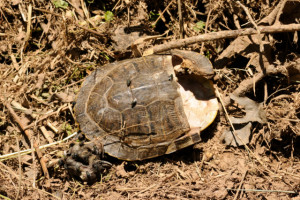
A slow journey that began more than a million years before, ended at the tip of a mower blade spinning at 3,200 rpm. This wood turtle, listed as ‘threatened’ in New Jersey, was killed in late May, while on its way to lay eggs.
May and June have been the peak of the great turtle migration where females, laden with eggs, leave the protection of quiet places to journey far and wide to dig holes and bury their eggs. Incubation takes about 70 days, more or less, and nests are left unattended.
All species, whether aquatic, terrestrial or both, like the wood turtle, seek dry land to lay eggs. Each has a preference for where and when they dig nests, though individual variation is the rule.
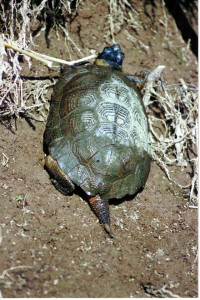
A wood turtle on its way out of the river where it hibernated to lay eggs in the gravel soil near railroad tracks.
Wood turtles prefer gravel laden soil on high ground, as found along railroad tracks, roadsides and driveways.
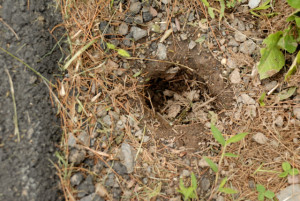
Roadways have become the killing fields for these slow moving reptiles where large blocks of undisturbed habitat are segmented by roads. A preserved island of land may be celebrated as a conservation success but the lack of linear greenways to bridge these islands is a death knell for many small creatures as it exposes them to predation and roadkill.
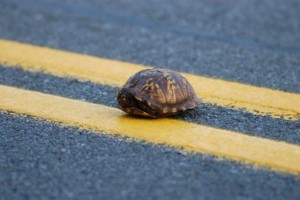
Eastern box turtle pauses mid journey across a New Jersey roadway, in a false retreat that offers no protection form speeding vehicles.
Turtles are creatures of habit and maintain consistent pathways from year to year. So that eastern box turtle you saw crossing over the double yellow line last year will be crossing the road in the same place this nesting season.
Mowing tall grass during nesting season is a more insidious cause of death for turtles and grassland nesting birds. Many farmers and landowners alter their mowing schedule to prevent killing fawns and game birds; turtles and grassland nesting birds are coincidental beneficiaries.
State conservation organizations advocate mowing early in the season and then not again until August, late July at the earliest.
A driver may possibly avoid killing a turtle on a paved road as it is somewhat visible, while a turtle in tall grass is a foregone conclusion when a mower runs through a field. The fractured shell of the wood turtle pictured, was found on a path mowed through an overgrown pasture near the South Branch.
Females may travel half a mile from wet areas to lay eggs, so please be careful. As the wood turtle is considered, “threatened “, and known to populate our area, special caution should be taken. May 29, 2015, a female wood turtle was observed digging a nest within inches of a long paved private drive, in hard packed gravel. This would be the last place you’d ever expect a turtle to dig, as you would be hard pressed with a pick and shovel to penetrate that ground. The hole was about 5 inches deep and 4 inches wide.
An awareness of turtles and their nest sites are a prerequisite to protecting them. As the eggs are laid in a small hole, covered and left unattended, you’d never know you were endangering a nest. Many eggs don’t hatch or are destroyed by predators. Then imagine an inch long hatchling trying to traverse a quarter mile through fields and open ground in an effort to reach water, bog or swamp. Survivors are few and far between.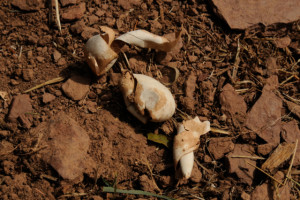
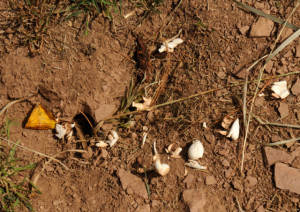
…you will find collapsed leathery egg shells scattered about; though they won’t look like egg shells. Imagine an egg shell make of cloth and inwardly collapsed to appear as a scrap of white material.
With poor odds for survival, it begs at least awareness on our part to, “first, do no harm”, and avoid destroying nests or mulching hatchlings and adults with a mower.
Turtles remain in their essential form that traces back to prehistoric times. Their evolution is an unrivaled success, even more astounding when their slow lumbering movements and low reproduction rate are considered.
Some interesting anatomical features reveal the secrets hidden behind the shell. See how the spinal cord is integral to the carapace or top shell in this painted turtle. The box turtle shell shows the spine as well as the clavicle. The thin plates that line the outer surface of the shell are attached much like a fingernail.
The easiest way to find a turtle nest is to look for the open holes in late summer and early fall. Either the nests were naturally opened by emerging turtlettes or dug out by raiding predators. In either case you will find collapsed leathery egg shells scattered about; though they won’t look like egg shells. Imagine an egg shell make of cloth and inwardly collapsed to appear as a scrap of white material. Last year I found 6 nests, one, just outside my back door. I had never seen a nest before but once I knew what to look for, they seemed to be everywhere.
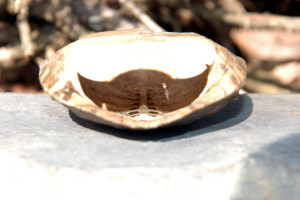
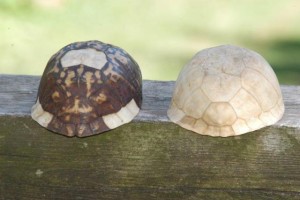
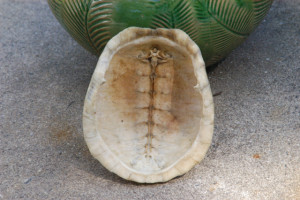
The Unami, one of the three matrilineal clans of the Lenape indians, who lived in central New Jersey, were known as the Turtle Clan. Treating the turtle with respect, keeps the clan of the turtle alive and well in the land it has known since the last glaciers receded and the land emerged from the sea. Consider, the turtle had arrived at it final evolutionary form long before humans. As new to the neighborhood, we might look to the turtle for guidance as we would a centenarian, to seek advice on how to live a long life in alignment and peace with our ever changing environment.
Author Joe Mish has been running wild in New Jersey since childhood when he found ways to escape his mother’s watchful eyes. He continues to trek the swamps, rivers and thickets seeking to share, with the residents and visitors, all of the state’s natural beauty hidden within full view. To read more of his writing and view more of his gorgeous photographs visit Winter Bear Rising, hiswordpress blog. Writing and photos used with permission from the author.
The LRWP is excited to be a part of “Citizen Science Monitoring for Pathogen Indicators in the NY-NJ Harbor” – a grant secured by NY-NJ Baykeeper to monitor local waters for pathogens in Raritan Bay. Funding for training and sample analysis is provided by the NY-NJ Harbor Estuary Program. Volunteers are needed for summer monitoring, with training to start in May.
Volunteer civic scientists from the LRWP and Bayshore Regional Watershed Council will help the NY-NJ Baykeeper collect water samples this summer at sites along the shores of Raritan Bay & Sandy Hook Bay. The LRWP and Raritan Riverkeeper will coordinate sampling at the three sites in Perth Amboy identified in this map. Bayshore Regional will cover the remaining sites. Training will start in May and will involve field, lab and data management procedures. We will follow strict quality assurance and quality control procedures approved by the U.S. Environmental Protection Agency (EPA).
Our goals with this project are to generate high quality, credible data on the health of our waterways, suitable for a wide variety of users. This information can help government agencies and the public make decisions about water quality improvements, habitat restoration, and recreational use. Volunteer monitors will gain important science skills and experiences while strengthening their connection with, and care of, local resources.
We need volunteers (YOU!!!) to help. Do you have time this summer to collect water samples so we can learn about our River? Do you want to gain a new perspective on the Raritan and have a lot of fun? Do you want to take your environmental stewardship to a new level?
To volunteer please e-mail Heather hfenyk AT lowerraritanwatershed DOT org
(This opportunity is an especially good resume builder – perfect for college students!)
By Elizabeth Dabundo, LRWP Green Infrastructure & Planning Intern
In the first of the LRWP’s Natural Asset Mapping speaker series we hosted two wonderful speakers, JeanMarie Hartman and Jessica Jahre, on the topics of the importance of riparian areas and floodplains.
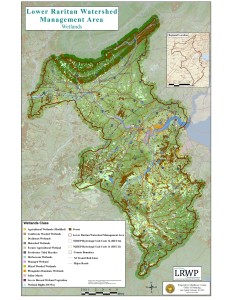
Wetlands of the Lower Raritan Watershed, Map by Jeanine Kopec-Zanghi
Rutgers Professor JeanMarie Hartman, Director of the Hartman Lab of Watershed Systems Studies, spoke on the importance of preserving riparian areas around streams as “buffer zones” for stream and habitat protection. She explained that the best type of “green infrastructure” for flood protection is the kind that doesn’t have to be engineered or installed – it is the natural “infrastructure” already found in forests and wetlands. It is best to keep a 300-foot buffer zone around streams in order to keep the stream itself, its inhabitants, and the surrounding watershed healthy. Professor Hartman explained these conclusions as almost common sense, but provided findings from an ongoing study of watershed management in Lower Raritan Watershed streams (Bound Brook and Lawrence Brook) that demonstrate a positive relationship between forest and wetland cover and biological water quality.
The study measured the presence of three groups of macroinvertebrates (aquatic animals) in the streams to determine stream health. Certain macroinvertebrates are more or less sensitive to environmental pollutants, and they can be grouped thusly:
-Pollution Intolerant (mayflies, stoneflies, caddisflies)
-Pollution Sensitive (dragonflies, damselflies)
-Pollution Tolerant (aquatic worms, midge larvae)
The presence of more pollution intolerant or pollution sensitive macros in a stream signifies that the stream and its waters are unimpaired, since they cannot live within polluted waters. These are often found in shaded streams with low levels of fine sediments, which not surprisingly are often streams with significant riparian buffers.
Next, Jessica Jahre of Princeton Hydro spoke on the importance of healthy floodplains. Floodplains are the areas surrounding streams and rivers that flood periodically, relating to risk. We often hear of 100-year or 500-year floods, but recently, we have seen more frequent and more intense flooding in the Lower Raritan Watershed. Floodplains are expanding, and more people are being put at risk for residing in or near the floodplain. Ms. Jahre explained that a healthy floodplain is integral for mitigating flood risk and damage in our communities, and she explained how she works with flood claims data to identify the areas most at risk.
It is important for a floodplain to be healthy in order to not only reduce instances of flooding, but also to improve water quality, recharge aquifers, and create wildlife habitat. It is often the case that floodplains have to be enhanced from current degraded conditions. This process includes reforesting or naturalizing (removal of development) floodplains, reconnecting the stream to the floodplain, lowering the floodplain through re-grading, or hydrologic restoration (eliminating abandoned agricultural ditches, removing dams). The problem we face in New Jersey and in many other densely populated areas is that development often comes right up to or is centered around rivers or streams, which only become more prone to flooding as the floodplain becomes more impaired through development and deforestation. In order to minimize future risks from flooding, we must enhance and improve our floodplains statewide.
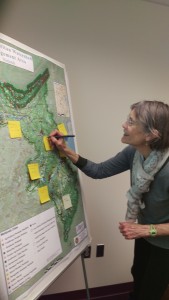
Susan Edmunds identifying riparian areas of interest
Thank you to our wonderful speakers and attendees. Next up in the speaker series are presentations on Lower Raritan Watershed recreational assets and neighborhood, cultural, and historic assets. Please join us on March 15 from 9:30am-12:00pm at the Middlesex County Administration Building, 75 Bayard Street, New Brunswick.
Speaker themes for 2016 include natural resource assets, cultural and historic assets, transportation and mobility assets, seeing brownfields as community assets for restoration, and economic assets, innovation, & regional planning. We are very excited for the opportunity to have state and regional experts on these topics join us for these presentations, and we hope you will join us as well! Please see our events page for more information.











